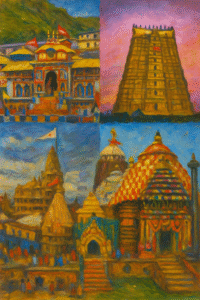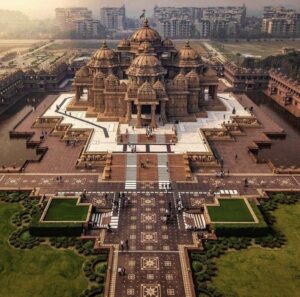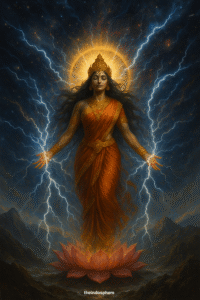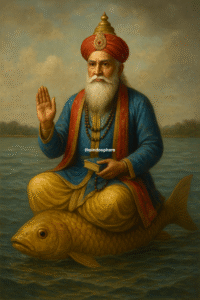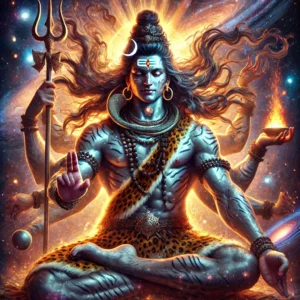
Among the most revered figures in Indian civilization, Bhagwan Krishna occupies a central place in religion, philosophy, literature, art, and cultural identity. He is worshiped across Hindu traditions as the Supreme Being, an avatar of Vishnu, and a divine guide. Beyond theology, Krishna’s presence extends into history, geography, politics, music, and moral philosophy, making him one of the most complex and multi-dimensional personalities in world tradition.
Birth and Early Life
According to traditional accounts, Krishna was born in Mathura, in present-day Uttar Pradesh, to Devaki and Vasudeva. His birth is traditionally dated to the end of the Dvapara Yuga, around 5,000 years ago, though historical scholars usually place Krishna’s life around the late 2nd millennium BCE or early 1st millennium BCE.
His birth was marked by political turmoil. His maternal uncle, King Kamsa, had usurped the throne of Mathura and, fearing a prophecy that Devaki’s child would be his destroyer, imprisoned his sister and brother-in-law. When Krishna was born, Vasudeva secretly carried the infant across the Yamuna River to Gokul, where he was raised by Nanda and Yashoda.
Krishna’s childhood in Vrindavan and Gokul is filled with stories of divine playfulness — stealing butter, charming the gopis (cowherd maidens), and performing miracles such as lifting Govardhan Hill to protect villagers from torrential rains. These episodes symbolize his role as protector and nurturer.
Krishna in History and Geography
The regions most associated with Krishna are Mathura (his birthplace), Vrindavan and Gokul (his childhood), Dwarka in Gujarat (his later kingdom), and Kurukshetra in Haryana (the battlefield of the Mahabharata). Archaeological explorations in Dwarka suggest the existence of an ancient submerged city, which many believe to be linked with Krishna’s legendary kingdom.
Though it is difficult to establish Krishna’s exact historical timeline, he is deeply woven into India’s historical consciousness. References to Krishna appear in early texts such as the Chandogya Upanishad, the Mahabharata, and the Harivamsa Purana, indicating his antiquity and widespread worship by the first millennium BCE.
Role in the Mahabharata
Krishna plays a pivotal role in the Mahabharata, India’s greatest epic. As a prince of the Yadava clan and relative of both the Pandavas and the Kauravas, Krishna becomes a key political and moral guide.
During the great war at Kurukshetra, Krishna serves as the charioteer of Arjuna, one of the Pandava brothers. It is here that he delivers the Bhagavad Gita, a dialogue that has become one of the most influential philosophical texts in world history.
The Gita addresses profound questions of duty (dharma), righteousness, action, devotion, and the eternal nature of the soul. Krishna teaches Arjuna to act selflessly without attachment to results, to uphold dharma, and to surrender to the divine will.
Teachings and Philosophy
Krishna’s philosophy blends devotion (bhakti), knowledge (jnana), and action (karma). He emphasizes:
- Dharma (Righteous Duty): One must fulfill their responsibilities according to their role in society and life.
- Bhakti (Devotion): Complete surrender to God is the highest path.
- Detachment: Perform action without clinging to its fruits.
- Unity of the Divine: Krishna identifies himself with the eternal Absolute, making him not just an avatar but the very embodiment of divinity.
The Bhagavad Gita has influenced Indian saints, reformers, freedom fighters like Mahatma Gandhi, and philosophers across the world.
Later Life and Dwarka
After defeating Kamsa and liberating Mathura, Krishna established his kingdom in Dwarka on the western coast. He became a statesman and strategist, guiding the Pandavas through diplomacy and war. His later years are marked by the tragic internecine conflict of the Yadava clan, which led to the eventual destruction of his dynasty.
According to tradition, Krishna left his mortal body at Prabhas Patan (near Somnath, Gujarat), where he was struck by a hunter’s arrow. This event marks the end of the Dvapara Yuga and the beginning of the current Kali Yuga.
Krishna in Religion and Worship
Krishna is worshiped in countless forms:
- As Bal Krishna (child Krishna), adored for his mischief and innocence.
- As Govinda and Gopala, the divine cowherd of Vrindavan.
- As the lover of Radha, representing supreme love and devotion.
- As the philosopher of the Gita, symbolizing divine wisdom.
- As Jagannath of Puri, one of the most famous forms worshiped in the Char Dham pilgrimage.
Major Krishna festivals include Janmashtami (his birth celebration), Holi (festival of colors, linked with his Vrindavan pastimes), and the Jagannath Rath Yatra.
Krishna in Culture, Arts, and Literature
Krishna’s stories have inspired classical Indian dance (Bharatanatyam, Odissi, Kathak), music traditions (bhajans, kirtans), miniature paintings, sculpture, and temple architecture. His divine romance with Radha symbolizes the soul’s longing for union with the divine.
In literature, poets like Jayadeva (author of Gita Govinda), Surdas, Meera Bai, Chaitanya Mahaprabhu, and countless others centered their devotion around Krishna.
Legacy and Significance
Krishna is not only a deity but also a civilizational symbol. He bridges the roles of child, hero, lover, warrior, philosopher, and divine guide — embodying the fullness of human and cosmic existence.
His life story weaves together myth, history, philosophy, and devotion, tying together diverse Indian communities from north to south, east to west. Even today, Krishna continues to inspire spiritual seekers, artists, and thinkers across the world.
Temples and Organizations Dedicated to Krishna
Krishna is worshiped in thousands of temples across India and abroad, some of which are among the most important pilgrimage centers in Hinduism. The Dwarkadhish Temple in Dwarka (Gujarat), Banke Bihari Temple in Vrindavan (Uttar Pradesh), and the ISKCON Krishna Balaram Mandir in Vrindavan are key sites associated with his life and worship. In Odisha, the Jagannath Temple at Puri is one of the four sacred Char Dham shrines, where Krishna is worshiped in the form of Jagannath along with his siblings, Balabhadra and Subhadra.
Other notable temples include Sri Krishna Temple in Guruvayur (Kerala), Udupi Sri Krishna Matha (Karnataka) founded by Madhvacharya, and Prem Mandir in Vrindavan, a modern temple dedicated to Krishna’s leelas. Globally, the International Society for Krishna Consciousness (ISKCON) has spread Krishna devotion across continents, emphasizing the chanting of the Hare Krishna mantra, community worship, and philosophical teachings from the Bhagavad Gita and Srimad Bhagavatam.

